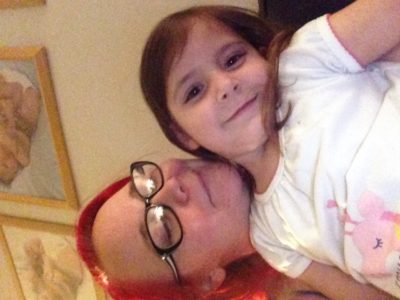I have been writing stories for a long time. I have been keeping journals since I was six and they are full of them. I always wrote about my actual day to day life in journals but never enjoyed autobiographical writing and didn’t think I was good at it. That’s entertaining now to think about, considering that I have spent the last four years digging out the hardest parts of me to share with the internet. But before I was Lisa from MastAttack, I was Lisa Klimas who wrote fantasy stories full of witches and magic that was intended to be shared with no one.
I don’t write fantasy stories anymore. (Except maybe the ones in my head where I fantasize that I’m not living in this body anymore.) I stopped when I started writing MastAttack; I’m not sure why, exactly. But even though I don’t write in this genre anymore, I am still very prone to seeing my life through the lens of fantasy; particularly, I relate aspects of my life to symbolic elements I used to use in stories. This is pretty obvious for anyone who has been reading for a while; I talk about the sky and stars and the vast endless space beyond this world in a lot of posts. Somehow, despite writing very frankly about my life, in my mind this is still a story about someone else, a fantasy story where anything could be real, and where the protagonist could do anything with the right magic.
The past six weeks have been difficult for me in ways that I could never have imagined. I was hospitalized for CDiff in Florida, and then again for CDiff in Boston shortly after I got home. On the last day of my second admission for CDiff, I found out that someone I love very much is very, very sick. The kind of sick that makes me numb to think about. It seemed like things started to level out with my health. I was pretty beat up but the infection seemed to finally be under control, and I was more available to help out with family things. Things seemed more manageable. Until they weren’t.
Last week, I noticed a very minor skin irritation around my port access site. Very minor. The kind I have had many times before just by virtue of having mast cell disease and having fair skin that marks easily. But I’m very meticulous about my port so I called my home IV nurse to come look at it. She came and agreed that it was probably a mast cell reaction or a very minor skin infection. It wasn’t hot, swollen, or painful. The redness was faint and covered a very small area around the needle site. I had no fever, chills, or other signs of infection. She was so confident that it was just a skin irritation that we accessed the port. I called my PCP for some prophylactic cephalexin in case it was a skin infection and breathed a sigh of relief.
I woke up in the middle of the following night with a fever and a much redder and angrier looking port. I took mast cell premeds and went to the hospital immediately. And even the ER nurses and doctors didn’t think it was a serious infection. It still wasn’t swollen, painful, or hot. (For people wondering why I’m harping on this, the four cardinal signs of infection are tumor (swelling), rubor (redness), calor (heat), and dolor (pain).) But they weren’t taking any chances and we spent an hour finding a peripheral vein to use while we sorted out my port. My white count was elevated but it is always is. They told me that they expected I would be admitted, get a few doses of IV antibiotics through the port, and go home in a day or two with the port.
Things didn’t exactly happen like that. Over the course of the day, I got sicker. I started feeling sicker, and I started having more mast cell activation. My white count went from normal for me level to through the roof in a few hours. I was rushed into an interventional radiology suite where everyone still thought that the port was not really infected. They told me after the first incision that things looked good. Then they took out the port and all hell broke loose.
There was an infection underneath my port, beneath the port and chest wall. One that had been brewing for a while. Suddenly everyone was talking in loud voices and debriding the poorly numbed cavity. I should have asked for anesthesia before the procedure but I had never had an IR procedure that required more than fentanyl and midazolam so it didn’t occur to me until they were literally carving pieces of tissue out of my chest. That is not a mistake I will make again.
I was hospitalized for several more days, including a total of three days without a central line. I blew in the neighborhood of ten peripheral lines and it would have been more if I hadn’t had good nurses who babied them to try and make them last. I get IV benadryl six times a day most of the time and that’s part of why I have a central line. IV Benadryl is really damaging to blood vessels and soft tissue, and my blood vessels are already in pretty rough shape. Getting IV Benadryl through a peripheral vein is miserable. It feels like knives shooting up your arm. I used all my tricks and wrapped my arm up in a hot, wet towel for several minutes before every dose, and we diluted it and pushed it slowly and flushed it slowly, and it was still excruciating every single time.
They put in a PICC line last Monday so I could go home and keep up with my home IV meds and fluids. I came home on IV antibiotics every eight hours for the line infection and oral antibiotics every six hours to hopefully prevent me from getting CDiff again from the other antibiotics.
The catheter tip grew out Staph aureus, meaning I had a staph infection a couple of inches from my heart. I got very lucky that I was treated fast enough that it never become a fulminant bloodstream infection but it came pretty close. Another few hours and this story might have had a very different ending. As it is, I suffered a lot for several days, and left the hospital with a hole in my chest so deep that it is nearly to the chest wall, deep enough that I cannot pack it myself because I cannot see the bottom.
Part of the shock of this situation is that I have had a central line for four years and have never had an infection. I am a maniac about my line and sterilizing it and being meticulous not to contaminate anything. I avoid hospitalization like the plague so that I’m the only one touching my line. When my last port was removed, after three years and three weeks, I was told that it was the longest continually accessed port in a BWH patient never to be infected. In total, I had three central lines (a PICC line and two ports) for three years and eleven months before we found any evidence of infection.
I couldn’t figure out how it got infected, and especially how the infection got behind the port. In retrospect, I think might have been contaminated when it was implanted. I don’t know how else I would have seeded a bacterial infection between the port and chest wall, but not over the port at all. I’ve felt sicker and more activated the last few months and it’s possible I had an infection growing all that time. It’s also possible that this isn’t the case but my instincts feel like this is the explanation. Either way, I’m never going to know for sure.
I came home earlier this week and was very relieved to see my family, my dogs, and my bed. I wasn’t feeling super but I just had a line infection so I wasn’t really expecting to.
Yesterday, I started having a GI bleed bad enough that I called an ambulance. While on the phone with 911, I started having anaphylaxis because that’s just how we do now. I laid down and used an epipen while feeling pretty dejected that I was now going to be admitted to the hospital for the fourth time in six weeks. I have been admitted for a total of 17 days this year. We are only 49 days into 2018.
Last night, I sat in my isolation room and watched it snow from the tenth floor. It was the middle of the night and the world was silent as snow covered every darkness and imperfection below. Not the terrible storm it was rumored to be. Just snow. Snow that is already melting under a clear blue sky and a brilliant and victorious sun. Light always wins.
I know that I am not really the protagonist of a fantasy story and that I’m not really going to slay the dragon that is my poor health. My health is bad. I have largely made peace with that. I want it to be better but I don’t expect it to be. But I also know that for every evil there is a pure good, and that bad things happen to me but the worst things don’t, and that I won’t always feel this way.
I don’t know how I will get through this or how long it will take or what I will lose along the way. I just know that the snow has fled under a brilliant sun and that somewhere, somehow, I will find a light.


